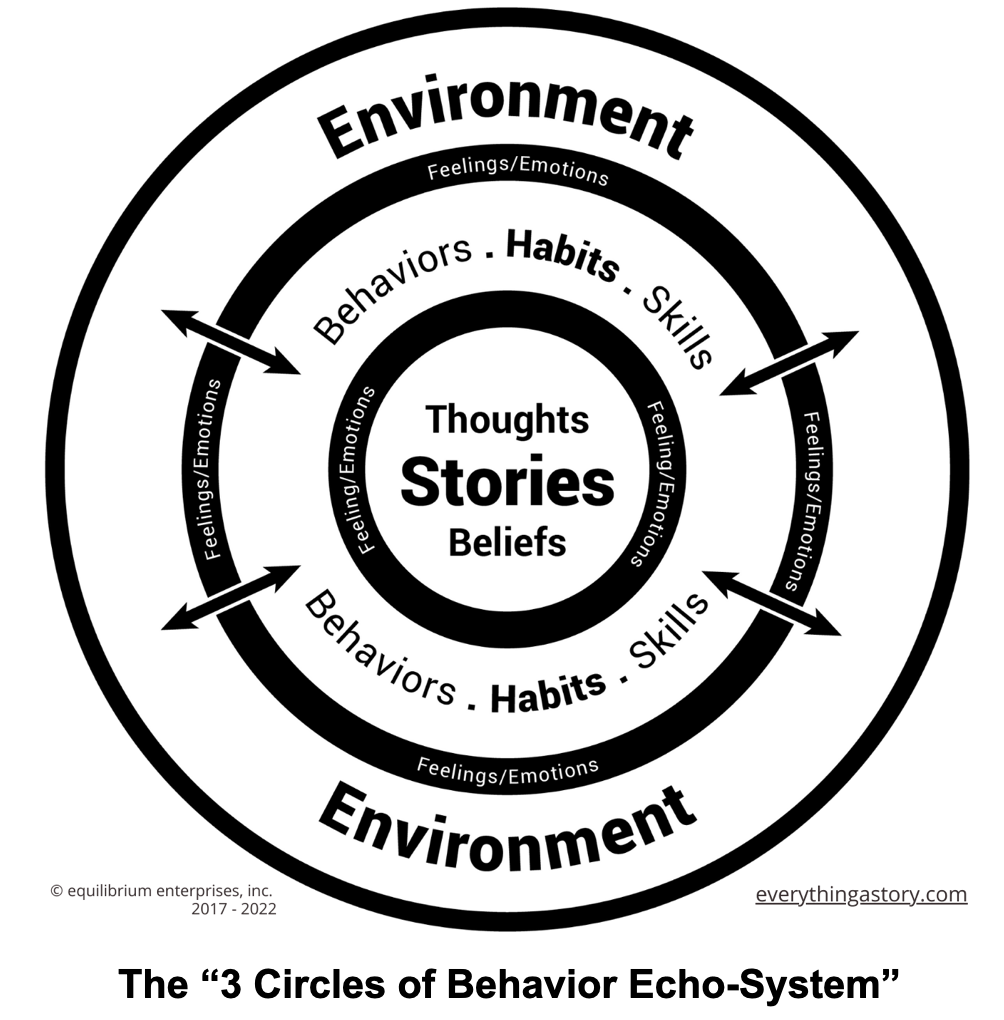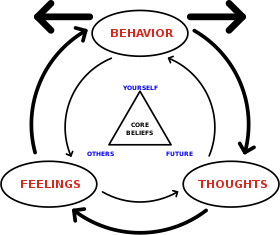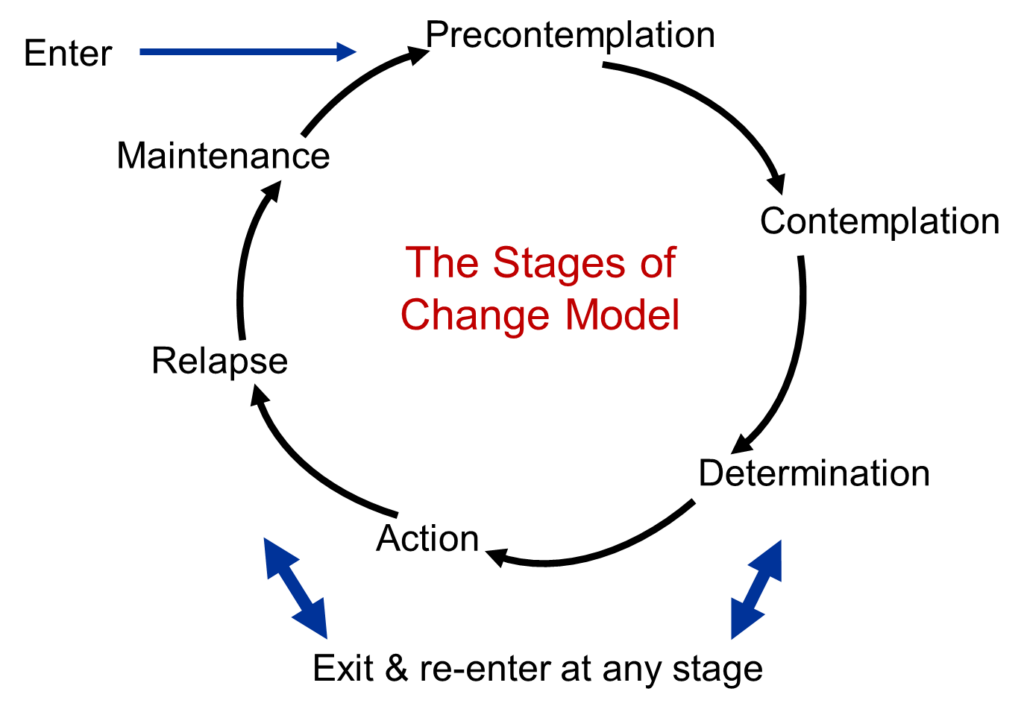
“Everything must be made as simple as possible, but not simpler.”
~ Albert Einstein
Older behavior models are confusing. They tend to represent human behavior in a linear, step-wise fashion—often looking like some sort of flowchart or business diagram.
The Behavior Echo-System™ is a new model that reflects how human behavior actually unfolds—within an echo-system.
Human behavior operates within a Behavior Echo-System™.
“There’s a reason you’ll hear things like, ‘I like the vibe here,’ or ‘That really resonated with me.’”
Environments, thoughts (stories), and certainly our behaviors echo—they all reverberate, influencing each other, directed of course by one’s focus.
Focus on a sad story, and what happens?
You may begin to tear up.
Focus on anger, and your jaw tightens, your voice sharpens—suddenly, the room feels tense.
Focus on gratitude, and your shoulders relax, your smile softens—others around you seem to smile too.
Catch a yawn in a quiet room? Seconds later, someone else yawns.
That’s a reverberation.
Ever witness a dog slink away from its angry owner—without a word being spoken?
The following is an excerpt from the 2015 edition of The Pressure Paradox™. Its purpose is to illustrate the parameters of human behavior and psychology in their most simplistic form.
Analyze the diagram above carefully. In simple terms, it represents the entire context of human behavior, bookended and influenced by two worlds: our inner, invisible world (thoughts) and our outer, physical world (environment).
Since the dawn of man, great philosophers have promoted and taught that it is the “first world,” our thoughts (the inner world), that directly influences and impacts our outer world. In fact, in the late 1800s, William James proclaimed,
The greatest revolution of our generation is the discovery that human beings, by changing the inner attitudes of their minds, can change the outer aspects of their lives
~ William James
[End of excerpt from The Pressure Paradox™]

Here is what has evolved…
STORY! A core thesis within EVERYTHING emphasizes the inner circle—the powerful idea that story is the primary means of cognitive function and analysis.
Behaviorally speaking, it is the primary medium through which we conduct our decisions, actions, and behaviors. It shapes our habits and skills, and ultimately forges our achievements and results.
Yet, no prevalent Behavior Change Model represents the human thought process as a STORY.
Emotions and Feelings
After further meditation and collaboration, it became clear that the borders within the concentric circles must include passageways—conduits between each influencing layer or component within a Behavior Change Model.
In the Behavior Echo-System™ model, emotions and feelings should be recognized as these conduits (or membranes), allowing energy, influence, and information to move between layers.
Without awareness and/or emotional maturity, emotions and feelings can dominate one’s behavior at any given moment.
Hence the distinction between an infant—who has no emotional regulation—and a stoic, who practices deliberate emotional restraint and reflection.
However, with some awareness and a degree of emotional maturity or reflection, their impact is significantly minimized, especially over time.
PPut simply: without emotional maturity, emotions and feelings have an immediate and powerful effect on behavior.
With emotional maturity—the ability to pause and reflect on the consequences of one’s actions—that immediate influence becomes much less pronounced.
Bidirectionality
The arrows between the major influencers have evolved to become bidirectional. This better illustrates how each primary component circle—environment, behaviors, and thoughts—echoes back and forth, altering our emotions and feelings, and continuously influencing the other layers within the eco-behavioral system.
Non-Linearity
Two of the most prevalent behavior change models—Cognitive Behavioral Therapy (CBT), considered the gold standard, and the Transtheoretical Model (TTM)—represent human behavior in a linear fashion.
The Behavior Echo-System™ model offers a more dynamic representation of how energy and information flow and reverberate through our thoughts and behaviors, depending on their forcefulness and direction. It reflects a more accurate, non-linear view of change.
Furthermore, the Behavior Echo-System underscores timeless principles such as cause and effect—and even touches on philosophical concepts like karma.
Awareness:
The Behavior Echo-System™ articulates how, with awareness, we can proactively alter our behavior by changing our thoughts (stories) and/or environment.
The Environment: The all-encompassing environment is both the sensory input and the output in the Behavior Change Model – our results. The environment is something we can change, and it’s something that influences our thoughts, feelings, emotions, and behaviors.
Simplicity
Finally, the 3 Circles of the Behavior Echo-System™ offer a refreshingly straightforward model. It follows Einstein’s guiding principle:
“Everything must be made as simple as possible, but not simpler.”
Simplicity tends to lead to practicality and ease of use—ultimately increasing effectiveness.
Older Behavior Models Are Incomplete.
The Behavior Echo-System™ (BES) is holistic, dynamic, and perpetual.
Everyone lives within their own Behavior Echo-System™.
While people can share an ecosystem, they cannot share an echo-system.
Why? Because each of us brings our own unique stories, thoughts, beliefs, values—and even our body and DNA (which are part of our internal environment and serve as behavior influencers).
While each of the following behavior models is incredibly helpful, they also reveal certain limitations. Most are step-wise, few address the entire behavioral landscape—for example, many overlook environmental influence—and some are simply too complex for practical use.
Behavior Shouldn’t Be Reserved for PhDs
Just as we teach children the basics of math (2+2=4) or language (A, B, C), we should be able to teach the fundamentals of behavior in a similarly accessible way.
Even though behavior can be deeply complex—like calculus or advanced linguistics—we don’t need to start there.
The Behavior Echo-System™ captures the technical accuracy and wholeness of human behavior, while presenting it in such a simple, intuitive way that even a seventh grader can learn and apply it.
Cognitive Behavior Therapy (CBT)

Transtheoretical Model (TTM)

The Behavior Echo-System™

This new behavior model provides anyone with the clichéd 30,000-foot overview to better guide them from being a reactionary participant to someone in a position of response-ability.
This Behavior Change Model illustrates how, over the long haul, environment, and story most significantly influence our behaviors, habits, and skills.
Important: The interaction among the three major influencers in this Behavior Echo-system – stories, habits/behaviors, and the environment – is not always linear. For instance, an environmental change might impact your story seemingly before affecting your behavior or emotions. Nonetheless, all components influence and affect each other perpetually in this Behavior Change Model.
Example: A person steps on a subway train at night in an unsafe part of the city. The change in environment and their situational awareness spark the narrative that their safety may be in peril. This is an example of the environment directly affecting someone’s story first. What action does the person take? They clutch their bag tightly.
Environment – (influences) -> Story –(influences) -> Action/Behavior.
With the 3 Circles of Behavior Echo-System model (and the three books taken as a whole), The Habit Factor, The Pressure Paradox, and now, EVERYTHING, the intention is to provide a better, more approachable behavior change model and framework that makes lasting, positive change and personal transformation easier.
This simply means that for any goal or ideal relative to personal transformation, the 3 Circles of Behavior Echo-System acts as a simplified checklist – a cheat sheet – for goal achievement and positive behavior change.
Important: All lasting behavior change requires these three major components to be congruent:
- STORY (the inner circle)
- HABITS/SKILLS (middle circle)
- ENVIRONMENT (outer circle)
While skills/behaviors and thinking/mindset are self-explanatory when it comes to the environment, there may be some confusion. We’ll take a moment to examine the concept of environment.
Environment defined: In the 3 Circles of Behavior Echo-System, the environment represents both sensory input and the output – outcomes, and results.
Inputs are cues and triggers in this behavior model, including circumstances, events, and the physical environment – everything that provides sensory input to affect your feelings, emotions, thinking, and behaviors.
Examples include family, friends, physical surroundings, and random events (accidents, chance). Even your body provides environmental input. If something is outside of your thinking, emotions, and behaviors, it’s part of your environment.
Importantly, the environment also includes your outputs.
Your outputs are your results in a Behavior Echo-system – what you affect and produce.
Your outputs may be the consequences of your actions, decisions, behaviors, habits, and skills.
As we mentioned above, even your body is part of your environment. For example, a bodybuilder experiences results that reveal their skills, habits, and behaviors. Their body (environment) is transformed (output).
Everything we produce and affect in our environment becomes a stimulus (sensory input).
Thus, a perpetual Behavior Echo-System is in effect.
Here are some examples of the behavior-change echo system in action:
Outside -> in behavior change:
A comet strikes just outside your house! (Environment).
You feel the Earth shake. You’re instantly startled and scared! (Feelings/Emotions)
You run out of your house. (Behaviors/Actions) You begin to think, “The world is ending!” (Thoughts/Story)
Summary: The environment directs and influences your feelings and emotions, directly influencing your actions and behaviors, which direct and influence your thoughts and story.
Inside -> out behavior change:
You wake up one morning with the narrative that the world and life are hopeless. “It’s all ending soon anyway.” (Thought/Story)
These thoughts (your story) influence your feelings. You feel sad and hopeless. (Feelings/Emotions)
You call a friend later that morning. (Behaviors/Actions).
Your friend comes over to talk with you and comfort you. (Environment change).
Summary: Your thoughts and story direct and influence your feelings and emotions, which direct and influence your actions and behaviors, which cause an environmental change.
You may be thinking, “So what? Why should I care about any of this?”
Here’s why: Ironically, change is one of the great constants in life. One of the best ways to direct change is to set goals.
Who doesn’t want to at least attempt to achieve their full potential? This Behavior Change Model reveals the path to do so.
Arguably, many never attempt to achieve their full potential because there is no clear Behavior Change Model, map, or process showing the way.
This book and model are it.
A bold statement, perhaps, yet understanding the fundamental components (the major influencers) of behavior change and personal transformation – how this Behavior Echo-System works – provides anyone the ability to determine where (in which component influencer) to begin their journey. It tells you how to develop habits that bring lasting change.
Would you like to start by modifying your thinking?
A new Behavior Change Model can undoubtedly help you drive new emotions that will foster new actions – the beginning of new habits and skills. (Personal example below.)
We’ll get more into the nuts and bolts of new narratives in the chapter called “The Stories That Really Freakin’ Matter.”
Do you want to begin your journey of personal transformation by changing your environment? This could be as simple as rearranging your office or home furnishings, altering your refrigerator or pantry inventory, joining a support group, or finding a different peer group to associate with.
Or, you can begin with my personal favorite, intentionally tracking your behaviors to help form the new, positive habits that will ultimately change your narratives, stories, habits, and environment.
The lasting transformation is metamorphosis.
By definition, you should know how to develop habits and skills to achieve metamorphosis. Therefore, any time you desire, you can initiate transformation by beginning with any of the three component influencers in the Behavior Echo-system:
- Thoughts/Stories
- Behavior/Skills/Habits
- Environment
What I find curious is that individuals not only have learning preferences and biases but also have preferences for initiating their own behavior change. Most of the time, they aren’t aware of it or any Behavior change model they should follow.
When I teach the 3 Circles of Behavior Echo-System, I’ll ask participants to reflect upon a recent behavior change effort, either successful or unsuccessful. A student who appeared excited by this model shared: “This is interesting! I tend to start with my environment. I bought a book recently.” Then, they laughed, “It’s sat on my bookshelf ever since.”
Some people prefer to initiate behavior change with their environment – a class, coach, course, teacher, support group, or even a book. Others tend to put the spotlight on the related personal narrative (their “Why?” story), as in why they must change their behavior and develop new habits. They know that a new story will drive compelling feelings and emotions followed by actions.
Finally, this critical message about transformation and personal metamorphosis bears repeating:
You should engage each major component (circle) and make them congruent for lasting transformation.
Ultimately, you should align and engage your story, skills/habits, and environment to foster legitimate, lasting change.
[From EVERYTHING is a F*cking STORY]
Postscript:
Alternative names that “3 Circles of Behavior Ech0-System” has been given: “Behavior Echo-Chamber*”, Behavior Eco-System**, Grunburg Behavior Model.
Note: The first two are innacurate labels and identifiers. This model is not an echo chamber. An echo chamber would represent a singular mechanism.
The 3 Circles of Behavior Echo-System is a “SYSTEM” of integrated components.
It’s also not an ECO system.
The objective is to represent the “system” and its component parts vibrating and influencing each other.
As for the third alternative name, The Grunburg Behavior Model, while easier to say it’s certainly less descriptive.
The purpose of the postscript is to address the inaccurate names that have already begun to be used. I greatly appreciate your understanding of the important distinctions.
Thank you!
~mg
“If you want to find the secrets of the universe, think in terms of energy, frequency and vibration.”
~ Nikola Tesla